Fish Molee, also known as Meen Molee or Fish Moolie, is a mild, coconut-rich fish stew from Kerala. Introduced by Portuguese settlers, it blends tender fish with coconut milk, curry leaves, and Kerala spices.
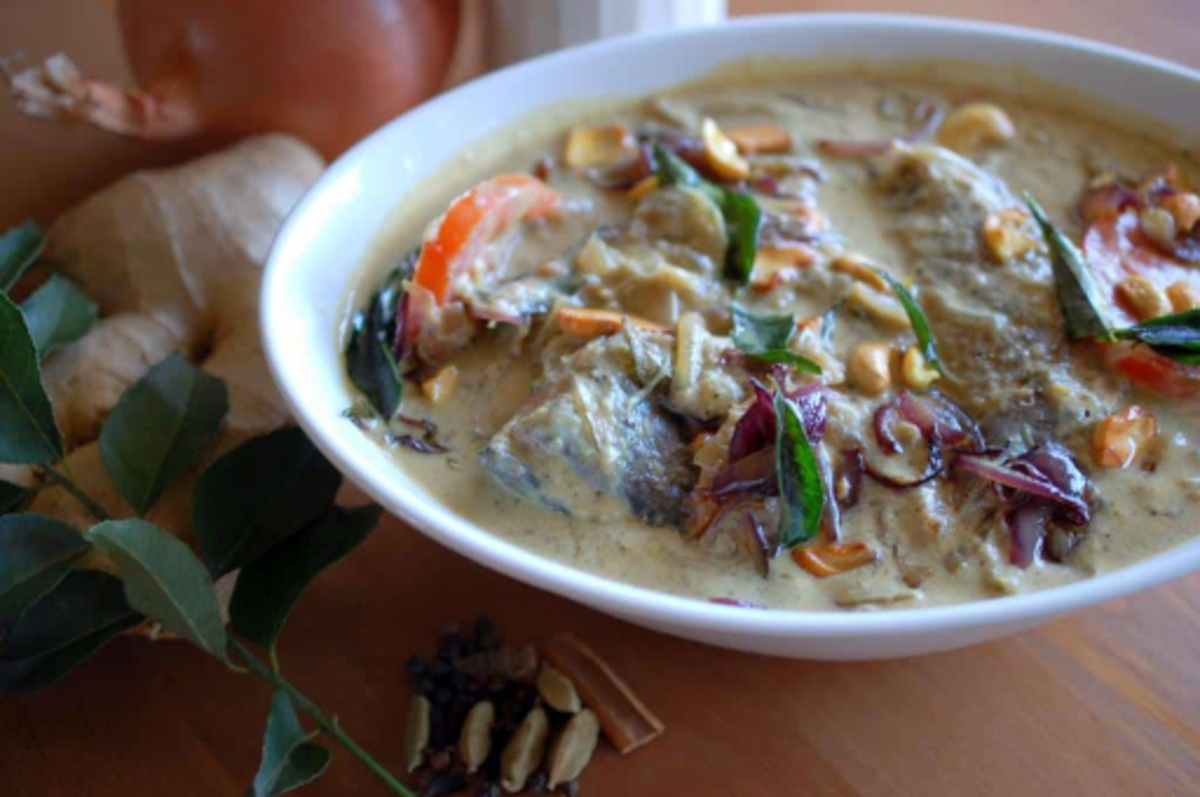
Traditionally served for breakfast or festive occasions, especially in Central Kerala.
Explore the ingredients, step-by-step instructions, serving ideas, and storage tips to prepare this comforting classic at home.
Jump to:
- What is Fish Molee?
- Why You'll Love This Recipe?
- Recipe Ingredients
- Variations to Try
- How To Make Fish Molee /Kerala style Fish Stew? (Step-by-Step Guide)
- Tips And Tricks
- Serving Suggestions
- Storage Instructions
- Frequently Asked Questions (FAQ)
- More Kerala Style Stew Recipes To Try
- Fish Molly / Molee (Fish Stew - Kerala Style)
What is Fish Molee?
Fish Molee is a Kerala stew in which fish is simmered on a coconut base with Kerala spices. It is a rich, creamy, tangy dish. Unlike traditional Kerala red curries, this dish has a milder spice from pepper and green chilies.
It is often served with appam (fermented rice pancakes), idiyappam (string hoppers), or steamed rice as a morning dish. Due to its perfect balance of flavors, this dish is one of the favorites among tourists.
The stew is spicy from peppers, creamy from coconut milk, and tangy from tomatoes. Kerala Style Chicken Stew is a similar option, and it is also loved for its creamy flavor.
Why You'll Love This Recipe?
You will love this recipe because it offers a perfect blend of flavors — a balance of spice, tartness, and creaminess. The vibrant yellow color is tempting.
The aroma of blended coconut and spices makes it even more irresistible. This Kerala stew can be paired with various dishes such as rice, Kerala Ghee Rice, pathiri, appam, naan, and more.
For more equally delightful and diverse Kerala non-vegetarian options, explore our Kerala Non-Veg Recipes!
Recipe Ingredients
- Fish – Always use fresh, thick, no-bone fish that will not break up while cooking and the danger of thin bones. For this recipe, I chose Pomfret.
- Powdered Spices – Turmeric powder, pepper powder, and fennel powder (perinjeerakam powder) are the main spices used in the dish.
- Whole Spices – Clove, cinnamon, and cardamom are the ones used. “Whole spices” are recommended over powdered form as they release a stronger aroma.
- Coconut Milk – For traditional cooking, you need two types of coconut milk. First coconut milk and second coconut milk. The first coconut milk is thicker. It comes from the first blend of coconut with water, which is then strained. Then, water is added to the residue and blended to make the second coconut milk. The second coconut milk is thinner. Both are added at different times in the recipe. If you don't have access to fresh coconut milk, you can use store-bought canned coconut. However, it’s not recommended for an authentic taste. If you're a fan of coconut milk-based dishes, don't miss our Kerala Style Duck Stew recipe.
Check out the Recipe Card below for the complete ingredient list along with their nutritional details.
Variations to Try
There are many variations of Kerala stew to try, mainly based on protein options like mutton, chicken, and beef. The steps are similar, but the cooking method for each type of meat differs.
You can try our Kerala Style Mutton Stew recipe for a flavorful variation. When it comes to variations in fish, you can choose any fleshy, less bony fish. Fishes like Pearlspot, Kingfish, and Seer fish are great options for Fish Stew.
For vegetarians, a vegetarian version is also available. In this version, vegetables like potatoes, green peas, and carrots are sautéed in coconut oil, and the other steps follow as usual.
How To Make Fish Molee /Kerala style Fish Stew? (Step-by-Step Guide)
- Clean the fish pieces well and marinate them with turmeric powder, salt, ginger, garlic, pepper powder, and lime juice( listed under marination). Keep it aside for 10 minutes.
- Heat oil in a flat pan. Shallow fry the fish pieces for 2 minutes on one side at medium flame. Keep it aside. This same method is also used in our Kerala Style Fish Biryani recipe
- Thinly slice the onion, small onion, and green chili.
- Heat oil in a pan. You can use the same oil used for frying fish. Splutter clove, cinnamon, and cardamom. ** If you are using the same pan to prepare gravy, remember to remove excess oil from the pan.
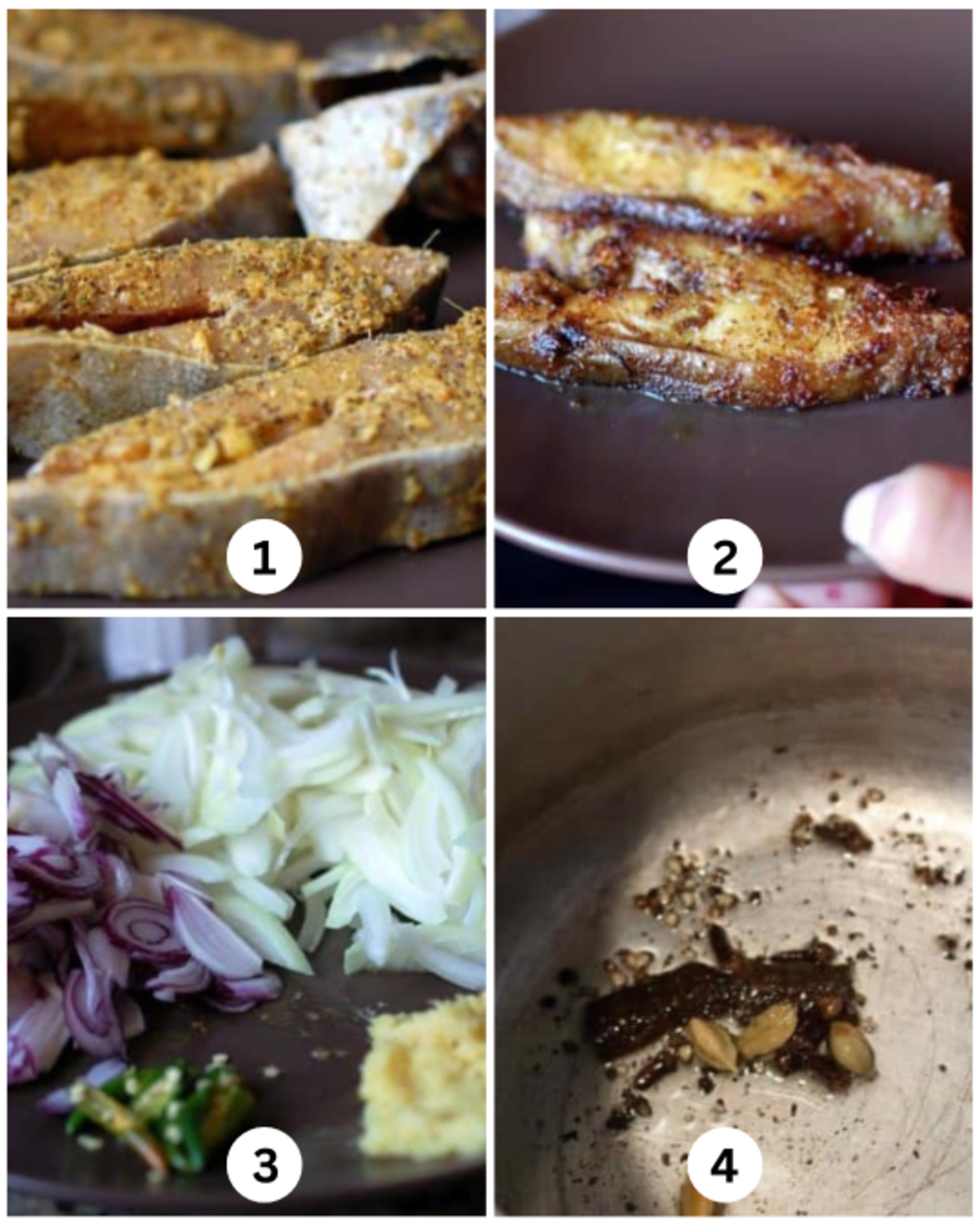
- Add sliced onion, small onion, green chili, and curry leaves, and salt it. Sauté it well until the onion is soft. ** You can partially replace small onions with regular onions also. Small onion always gives a better taste.
- Add ginger and garlic paste and sauté well. Add pepper powder and fennel powder and sauté well.
- Add medium-thick coconut milk. Adjust salt in the gravy.
- Then add fried fish and thinly sliced tomatoes. Make sure that fish pieces and tomatoes are immersed in the gravy. Cook for around 15 minutes on medium flame until fish and tomatoes are done.
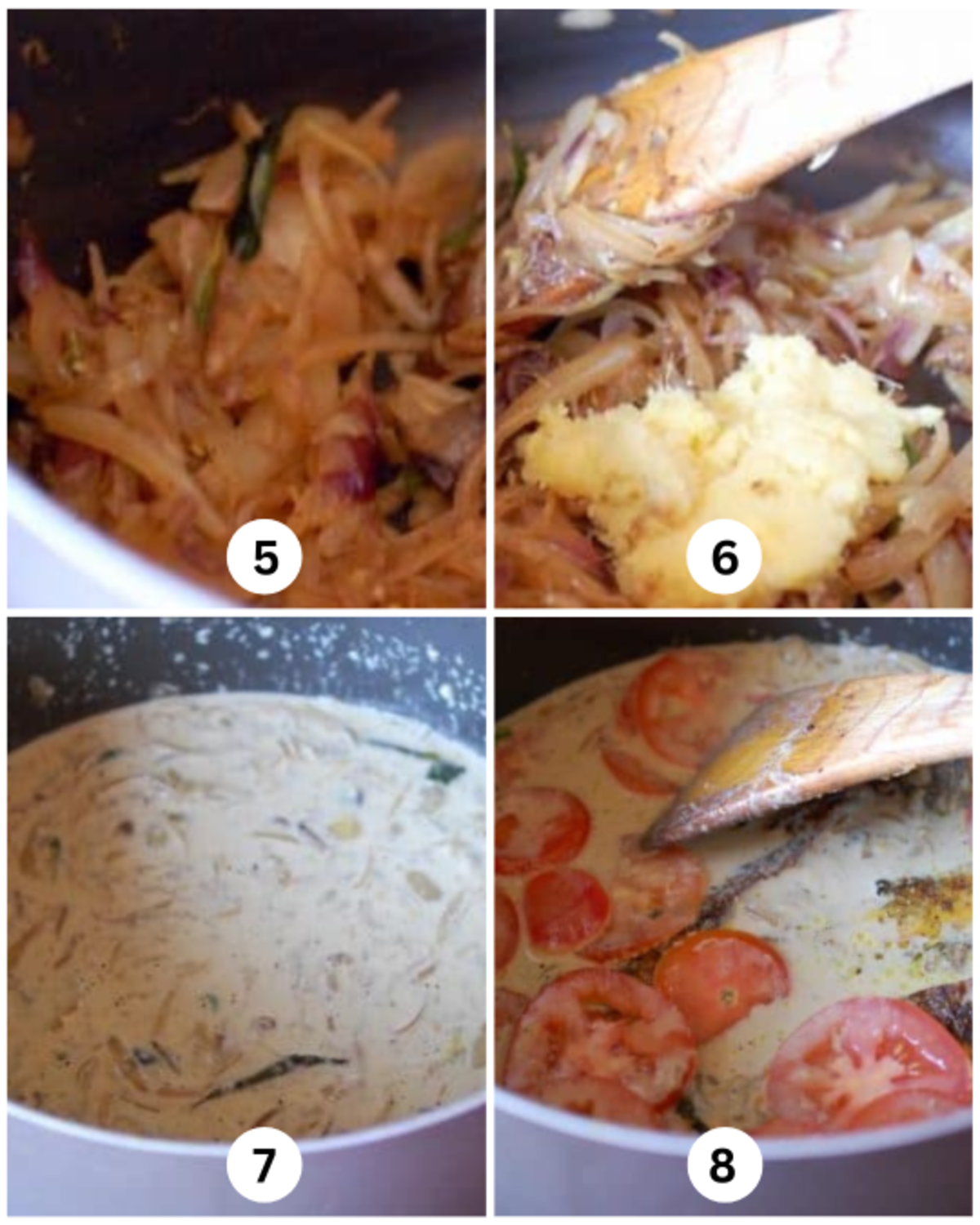
- Cashew paste is optional. Soak 1 tablespoon cashews in 2 tablespoons hot water for 15 minutes. Grind it to a smooth paste.
- Add thick coconut milk and cashew paste. Stir it carefully and bring it to a boil.
- Garnish - Fry small onion, cashews, and curry leaves. Decorate the dish with the prepared garnish and sliced tomatoes.
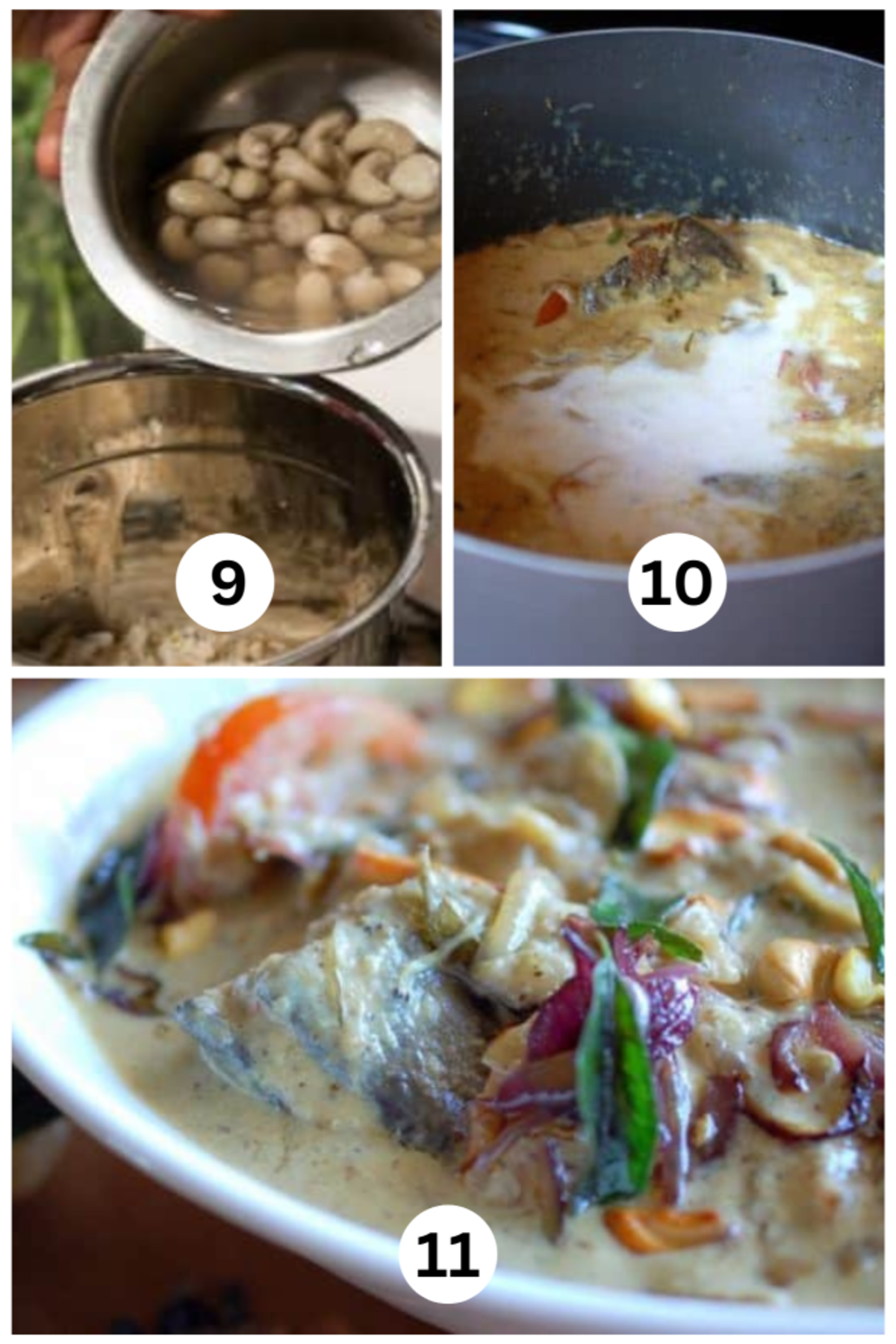
Tips And Tricks
- After adding the second coconut milk, avoid high-heat boiling. Overheating can cause the coconut milk to curdle and separate.
- Don't deep-fry the fish. Just shallow-fry. It will continue to cook in the simmering gravy. Frying it too much can cause the fish to become overcooked and break apart. For a crispy fried fish option, check out our Kerala Style Fish Fry recipe.
- Use freshly prepared turmeric powder if available. It will give a brighter, natural yellow color.
- Aromatic spices like fennel powder, cinnamon, or cloves are unavailable. You can use garam masala. It's not the ideal substitute, but it works as an alternative.
Serving Suggestions
Two of the best combinations with Kerala-style fish stew are appam and bread. It also pairs wonderfully with pathiri and idiyappam
You can serve it with Kerala steamed rice or ghee rice. Add some pickles on the side. Adding a pappadam (pappad) will elevate the dish.
It can also be served with chapatis, naan, rotis, or parathas. Whatever you choose, Fish stew will truly work its magic with the flavors.
Storage Instructions
When storing coconut-based curries, there are some limitations. At higher room temperatures, they spoil quickly. The coconut milk may split. If kept at normal room temperature and reheated frequently, it can last for a day.
For next-day use, refrigeration is the best option. Coconut milk-based curries stay fresh for only a few days. Freezing is possible but only for a short period.
After refrigeration or freezing, reheat slowly to prevent splitting. Curries like Traditional Kerala Style Fish Curry, which do not contain coconut, last longer.
Fish and coconut milk-based dishes should not be stored too long, as they quickly lose freshness.I don't recommend storing Fish Molee. Instead, try to make it fresh each time to enjoy its authentic flavors at their best!
Frequently Asked Questions (FAQ)
Add the second coconut milk towards the end of cooking to avoid splitting. Once the coconut milk is added, avoid cooking at a high flame. Keep the flame low and cook gently. Stir the mixture occasionally, but avoid vigorous stirring.
The best way to make Kerala-style fish stew spicier is by adjusting the pepper powder or by adding more green chillies. The pepper powder gives it an aftertaste, while the green chillies are much more deeply spicy.
More Kerala Style Stew Recipes To Try
I’d love to hear your thoughts if you have tried this! Please leave a ⭐️ rating and a comment below. Don’t forget to share your photos on Instagram and tag @a_little_bit_of_spice
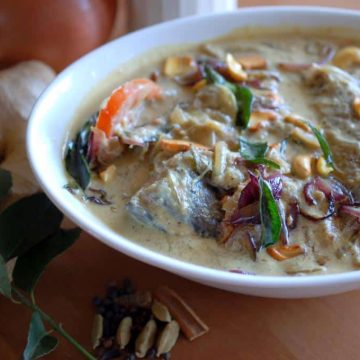
Fish Molly / Molee (Fish Stew - Kerala Style)
Ingredients
- ½ kg fish
Marination
- ¼ teaspoon turmeric powder
- ½ teaspoon salt
- 1 tablespoon ginger garlic paste
- 1 teaspoon pepper powder
- 1 teaspoon lime juice
Gravy
- 5 numbers clove
- 2 numbers cinnamon (1 inch stick)
- 2 numbers cardamom
- 1 number onion (medium)
- 1 cup onion (small)
- 1 sprig curry leaves
- 4 numbers green chilli
- salt
- 1.5 tbsps ginger garlic paste
- 1 ½ tsps pepper powder
- 1 ½ teaspoon fennel powder (perinjeerakam powder)
- 2 numbers tomato
- 2 cups coconut milk medium thick
- 1 cup coconut milk (thick)
Garnish
- 2 numbers onion (small)
- 1 tablespoon cashew nut
- curry leaves
- ½ number tomatoes
Instructions
- Clean fish pieces well and marinate it with turmeric powder, salt, ginger garlic, pepper powder and lime juice( listed under marination). Keep it aside for 10 minutes.
- Heat oil in a flat pan. Shallow fry the fish pieces for 2 minutes on one side at medium flame. Keep it aside.
- Thinly slice onion, small onion and green chili.
- Heat oil in a pan. You can use the same oil used for frying fish. Splutter clove, cinnamon and cardamom. ** If you are using same pan to prepare gravy, remember to remove excess oil from the pan.
- Add sliced onion, small onion, green chili, curry leaves and salt into it. Saute it well until onion is soft. ** You can partially replace small onion with regular onion also. Small onion always gives a better taste.
- Add ginger and garlic paste and saute well. Add pepper powder and fennel powder and saute well.
- Add medium thick coconut milk. Adjust salt in the gravy.
- Then add fried fish and thinly sliced tomatoes. Make sure that fish pieces and tomatoes are immersed in the gravy. Cook for around 15 minutes in medium flame until fish and tomatoes are done.
- Cashew paste is optional. Soak 1 tablespoon cashew in 2 tablespoon hot water for 15 minutes. Grind it to a smooth paste.
- Add thick coconut milk and cashew paste. Stir it carefully and bring it to boil.
- Garnish - Fry small onion, cashew and curry leaves. Decorate with the prepared garnish and sliced tomatoes. Serve it with Appam or Idiyappam or bread. Enjoy 🙂
Notes
- After adding the second coconut milk, avoid high-heat boiling. Overheating can cause the coconut milk to curdle and separate.
- Don't deep-fry the fish. Just shallow-fry. It will continue to cook in the simmering gravy. Frying it too much can cause the fish to become overcooked and break apart.
- Use freshly prepared turmeric powder if available. It will give a brighter, natural yellow color.
- Aromatic spices like fennel powder, cinnamon, or cloves are unavailable. You can use garam masala. It's not the ideal substitute, but it works as an alternative.
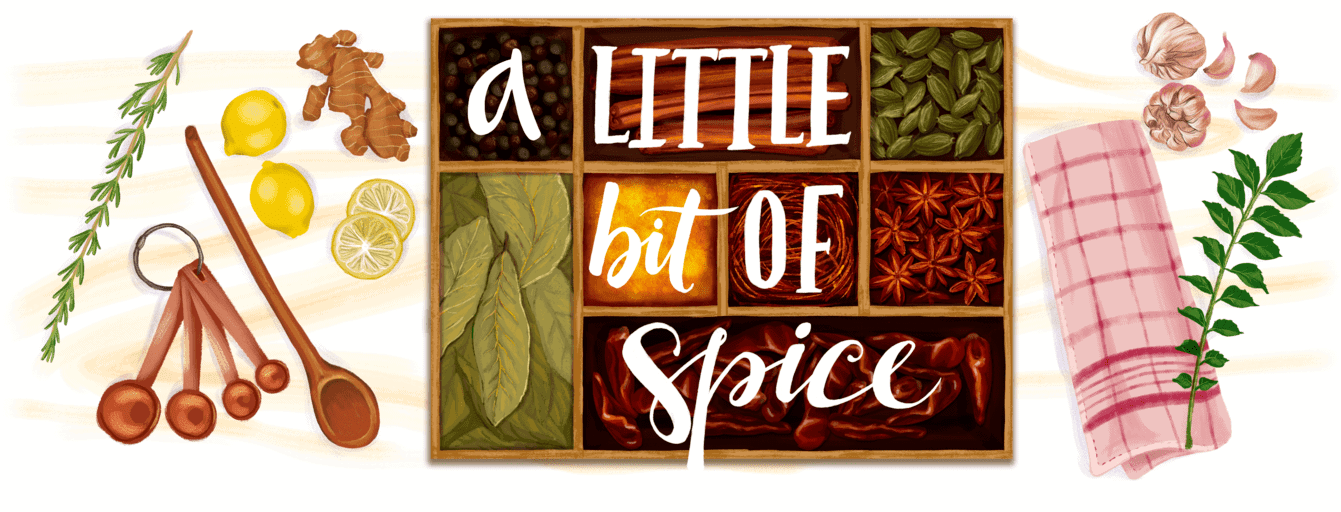

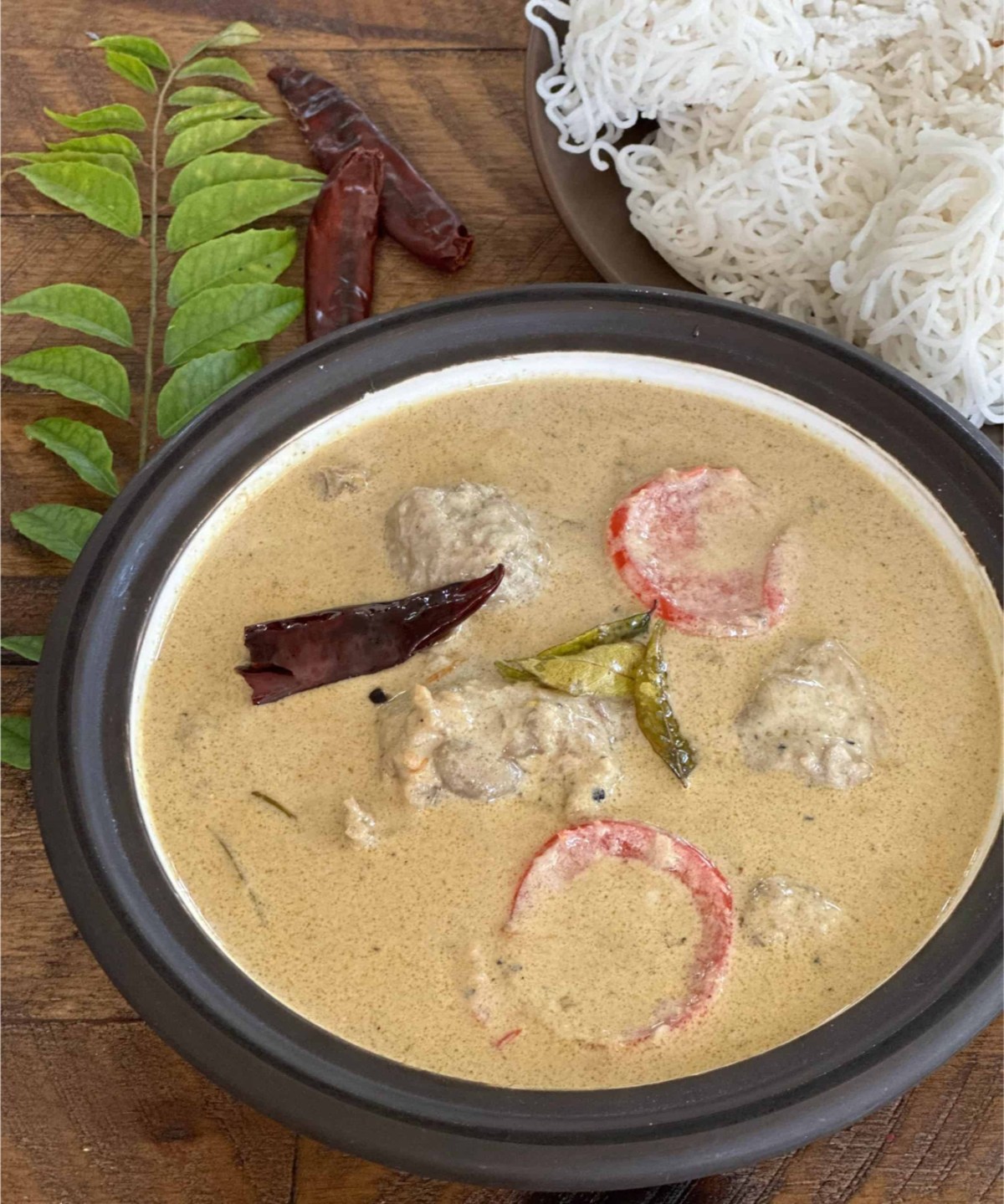
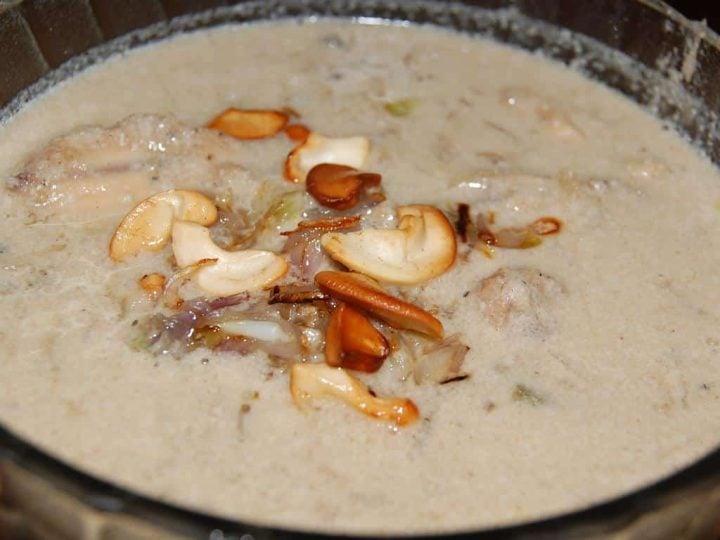
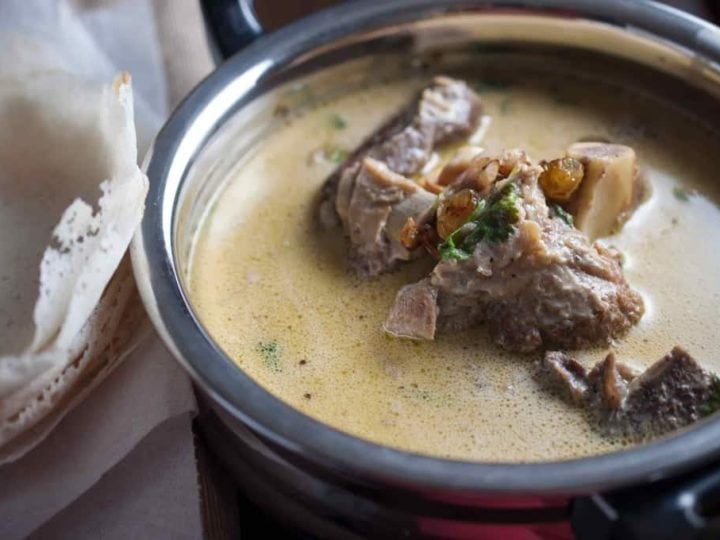
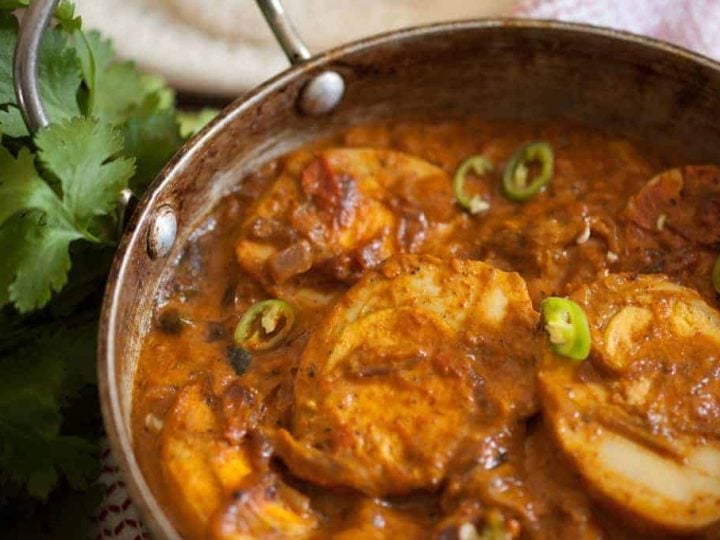
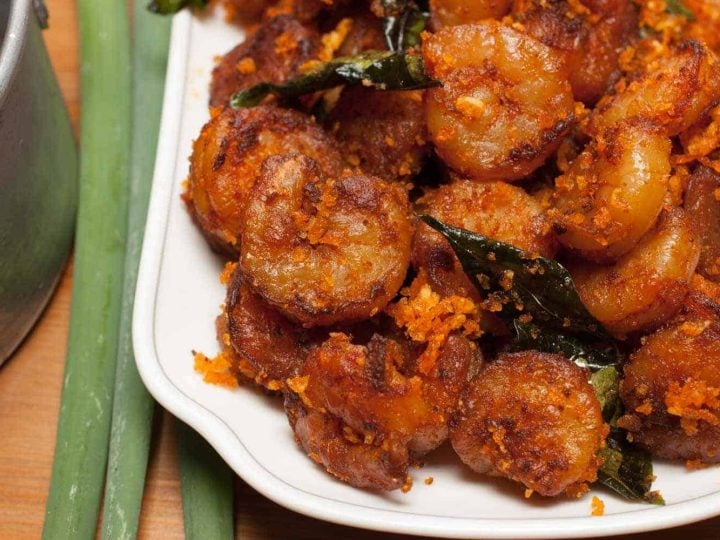
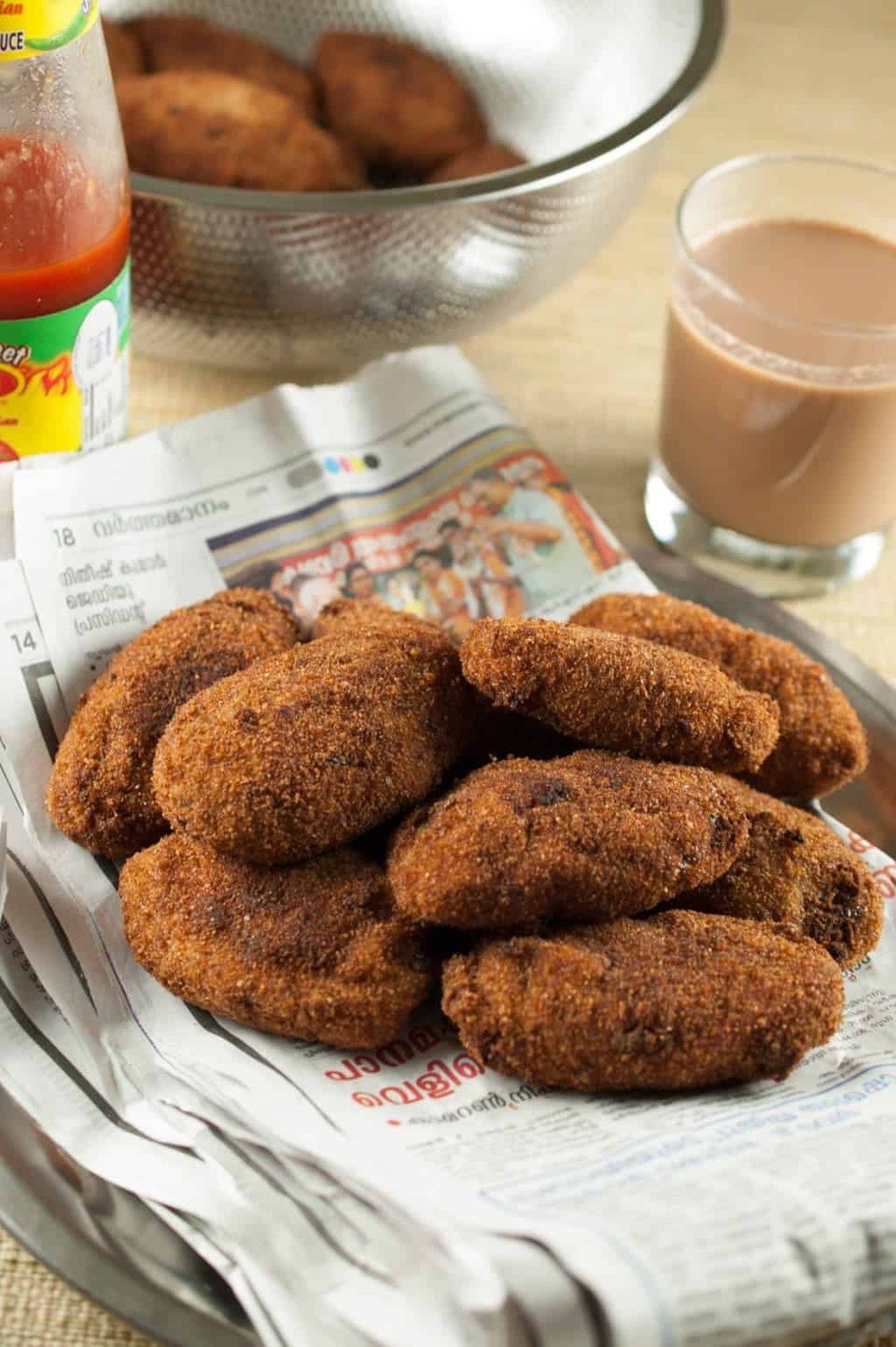
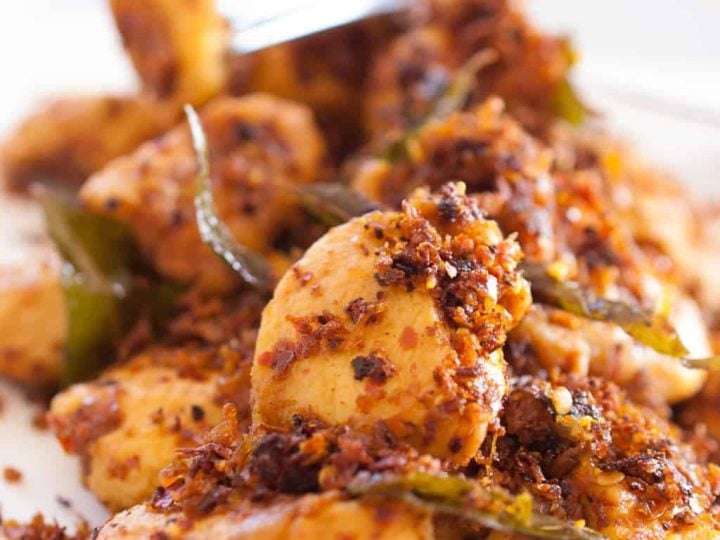
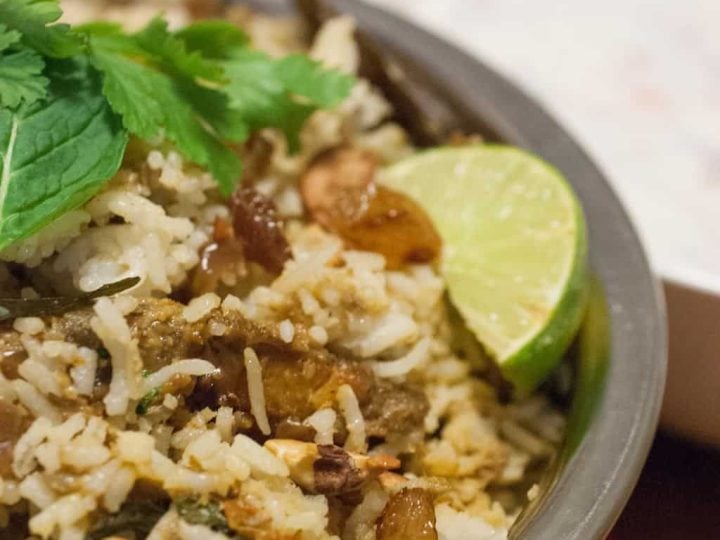
Looks yummy!!!Authentic kerala dish...Will try it soon and give you the feedback!!!
Thanks Rakesh! Lemme know how it turns out for you.
Is the print button working? Have tried it twice, but nothing is happening, not sure if it is me or a problem with the site.
Also, just wondering if “pepper powder” is supposed to be used in both the marinade and the cooking, I thought that chili powder was usually used in the marinade and wanted to check.
Finally, you mention aniseed powder in the cooking directions, but it is not included in the ingredients, so how much of is added?
Thanks, sorry for all the questions, Bindu
Sorry Bindu. Print button is not working. I will correct it soon.
Pepper powder is used in both marination and cooking. In fish molly, chilli powder is not used.
I have corrected this. It’s aniseed powder / fennel powder/ perinjeerakam powder. I have added the measurements for it.